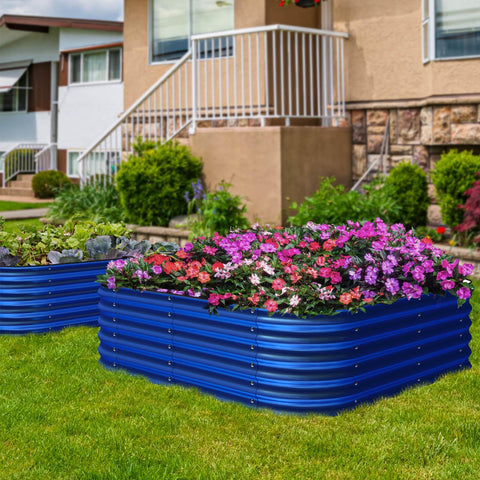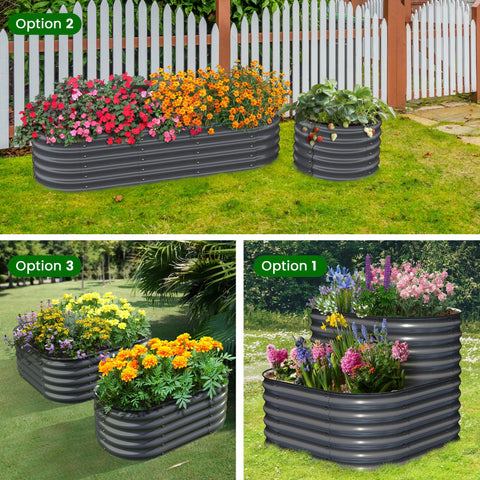The Knowledge from the Olle Garden Beds: Plant Selection and Care for Arch Trellises
ArchTrellis are a wonderful addition to any garden since they support climbing plants and give your outdoor area a sense of class. Arch trellises stand out among the numerous trellis forms because of their elegant, arching design, which can produce a gorgeous focus point in your garden. It's essential to carefully choose the ideal plants and give them the care they require if you want to get the most out of your arch trellis. We'll walk you through the process of selecting the ideal plants for your arch trellis and making sure they thrive in this blog.
Plant Selection
- Climbing Roses: Climbing roses are a classic choice for arch trellises. Their vibrant blooms and sweet fragrance create a romantic atmosphere in your garden. Varieties like 'New Dawn' and 'Cecile Brunner' are popular for their vigorous growth and beautiful blossoms.
- Clematis: Clematis varieties come in a wide range of colors and sizes, making them a versatile option for arch trellises. 'Jackmanii' and 'Nelly Moser' are two favorites known for their striking flowers.
- Wisteria: If you're looking for a dramatic display, wisteria is a fantastic choice. Its cascading clusters of purple, blue, or white flowers create a breathtaking spectacle when trained along an arch trellis.
- Honeysuckle: Honeysuckle vines offer not only beautiful blooms but also attract pollinators to your garden. Consider varieties like 'Gold Flame' or 'Drop more Scarlet' for a pop of color and fragrance.
- Jasmine: Fragrant jasmine vines, like 'Madison' or 'Star Jasmine,' provide a delightful aroma and lush greenery that enhances the charm of your arch trellis.
- Morning Glories: Morning glories are known for their vibrant, trumpet-shaped flowers that bloom in a variety of colors. They are easy to grow from seed and can quickly cover your arch trellis.
- Passionflowers: These exotic-looking vines produce unique, intricate flowers and can be a conversation starter in your garden. Varieties like 'Incense' and 'Lady Margaret' are particularly attractive.
- Hops: If you're looking for a functional addition to your garden, consider growing hops. They not only provide shade, but can also be used in home brewing.
- Perennial Sweet Peas: Unlike their annual counterparts, perennial sweet peas come back year after year, providing charming, delicate blooms in shades of pink, white, and purple.

Planting Tips
- Prepare the Soil: Ensure your soil is well-drained and enriched with organic matter before planting. This provides a healthy foundation for your plants to establish themselves.
- Spacing: Plant your chosen vines at an appropriate distance apart, typically 18-24 inches, to allow for proper growth and air circulation.
- Watering: Consistent watering is crucial, especially during the first year of growth. Use a soaker hose or drip irrigation to keep the roots consistently moist but not waterlogged.
- Mulch: Apply a layer of mulch around the base of the plants to retain moisture, regulate soil temperature, and suppress weeds.
- Sunlight: Most climbing plants for arch trellises thrive in full sun or at least partial sun. Ensure your trellis is situated in an area that receives adequate sunlight throughout the day.
- Support System: Ensure your arch trellis is sturdy and securely anchored in the ground. The weight of mature plants can be substantial, so proper support is essential.
- Deadheading: Regularly remove spent flowers to encourage continuous blooming and maintain a neat appearance.
- Overwintering: Some plants may require protection during the winter months, especially in colder climates. Mulch the base of the plants and consider covering them with burlap or a frost cloth.
- Companion Planting: Surround your arch trellis with complementary ground cover plants or low-growing flowers to enhance the overall aesthetic of your garden.
- Pruning Styles: Different plants require different pruning styles. While clematis and roses benefit from more vigorous pruning, some, like wisteria, may need less intervention. Research the specific needs of your chosen plants to prune effectively.
- Training Techniques: Experiment with various training techniques, such as fan-shaped, spiral, or horizontal espalier, to create unique and visually appealing patterns on your arch trellis.

Care and Maintenance
- Pruning: Regular pruning is essential to control growth and encourage more blooms. Prune in late winter or early spring when the plant is dormant.
- Training: As your plants grow, gently guide them along the trellis to help them adhere and create the desired shape.
- Fertilizing: Feed your plants with a balanced, slow-release fertilizer in the spring to promote healthy growth and flowering.
- Pest and Disease Management: Keep an eye out for common pests like aphids and powdery mildew. Address any issues promptly with appropriate treatments to protect your plants.
- Support: Ensure your arch trellis remains stable and well-maintained. Repair any damage to the structure promptly to prevent harm to your plants.
- Monitor Growth: Regularly inspect your plants for signs of pests, diseases, or unruly growth. Early intervention is often the key to maintaining healthy plants.
- Watering Schedule: Adjust your watering schedule based on the weather. During hot, dry spells, plants may need more frequent watering to prevent stress.
- Mulch Refresh: Periodically refresh the mulch around the base of your plants to maintain moisture retention and weed control.
- Seasonal Updates: Swap out your plants seasonally or yearly if desired. This allows you to experiment with different colors and textures throughout the year.
A careful choice of climbing plants and diligent maintenance are required to create a beautiful arch trellis in your garden. You may turn your outside area into a lovely and flourishing garden showcase by picking the appropriate plants, giving them the essential care, and exploring inventive training and maintenance strategies. Remember that gardening is a lifelong learning process, so don't be afraid to try new things and improve your techniques in order to get the greatest outcomes. Enjoy your garden!
